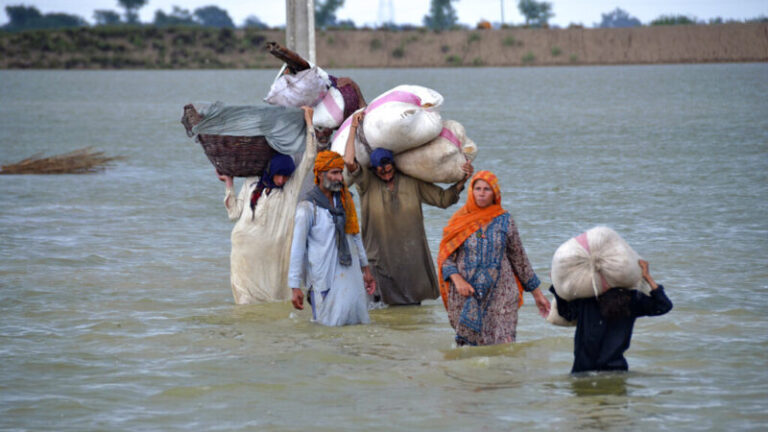As Pakistan grapples with one of the worst climate change crises, the lasting floods are likely to slash the GDP growth from 5% to 3%.
Pakistan is witnessing one of the worst series of flash floods that have ravaged settlements and claimed thousands of lives. With most of the northern region submerged in water and 81 districts continuing to be a calamity-hit zone, the challenges that the nation has to overcome are extensive.
As the crises worsen and no infrastructural facilities are functional for those who are hit by the crisis, the economic crisis is just beginning to unravel. As the fields submerge under water and partially no land is left visible, how will Pakistan deal with the toll of the apparent climate change crisis and what consequence it has on the economy of the nation?
Tracing Pakistan’s GDP growth over the years:
Pakistan estimated its GDP growth for the year 2021-22 to be 5.97%. This acceleration of the economic growth rate by 6% was the highest in four years and improved the extent of the economy to 383 billion. This boost of 6.03% was a 7.36% improvement from 2020, lending hope to a better future for the people of Pakistan as it ranked 43rd among the 196 countries as of 2021.
This optimistic rise is distorted by the severe climatic conditions that have resulted in destructive flash floods submerging one-third of the country. The floods have caused an estimated loss of 30 billion in monetary damages and a possible threat to thwart GDP growth.
According to recent media reports, these circumstances are likely to slash Pakistan’s GDP growth from the estimated 5% to 3%, adding to the massive loss inflicted by the floods.

Claiming approximately 1350 lives, the disastrous floods in Pakistan have caused massive destruction since the beginning of June. The problems have only been intensifying as shortages, starvation and anxiety plague the already suffering fraction of the country.
Citing the large-scale destruction and rising number of casualties, United Nations Secretary-General Antonio Guterres reflected on the unprecedented nature of these climatic conditions and urged international outreach to help cope with the disaster. He went on to say, “I have seen many humanitarian disasters in the world, but I have never seen climate carnage on this scale. I have simply no words to describe what I have seen today,” as he addressed the issue in Karachi.
With the cost of redevelopment of the infrastructure estimating 10 billion, the challenge for already indebted Pakistan is only getting harder. Along with this, the major difficulties of retaining substantial food availability and providing refuge to 33 million who have been displaced by the flood prevail as indispensable concerns.

Pakistan’s Climate Catastrophe: A Witness to the Climatic Breakdown
Most of the Global South is suffering the effects of environmental deterioration and has been feeling the tremors that climate change is provoking. With the rising sea levels, infections, famines, extended heat waves, flash floods, earthquakes and storms impacting the entire world, the impact is being felt contrarily. As more developing countries suffer the wrath of environmental degradation, the Global South-North divide widens as discussions about climate debts rise.
https://news.un.org/en/story/2022/09/1126001
Pakistan accounts for less than 1% of the global earth-warming gases, and 92% of the worldwide emissions released are induced by the Global North. This is raising the question as to who will pay the cost of losses as the already indebted developing countries have a trivial role to play in eliciting the climate crisis.
The combined rainfall for July and August was recorded at 391 mm, exceeding the 30-year-average. With the province of Sindh witnessing 466% more than the national average. These unprecedented events have pointed out that climate change is accountable for these catastrophes and stirred a debate about who should compensate for the damages.
The ongoing floods in Pakistan have impaired the agricultural sector, worsening the economic crisis and aggravating the already high inflation rate. Approximately 8.25 million acres of crops have been devastated, with much of the food repository being immersed in water. This will have a lasting global impact on rice and cotton availability, as Pakistan is one of the largest contributors. As the flood threatens to obstruct farming practices, the regional production of wheat, rice, and cotton will be affected, agitating shortages and a surge in prices increasing inflation.
Whether or not Pakistan will receive global aid to deal with this climate crisis is a question that only time can counter. But the damages that have already been done are extensive for a developing economy to endure. But in a time of such ongoing catastrophe, a global outreach to curb the impending crisis is the only prospect to tackle climate change.
https://news.un.org/en/story/2022/09/1127051












